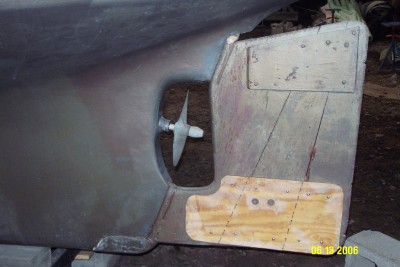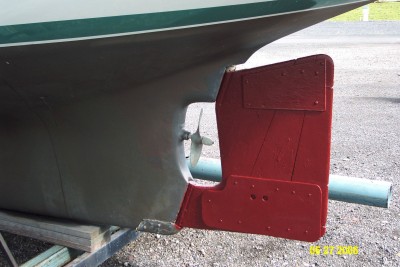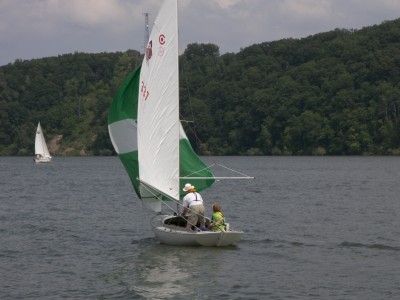
The New Pearson Wanderer
22 January 2006 | Rochester and Sodus Bay, NY
07 December 2005
15 September 2005 | Rochester and Sodus Bay, New York
Some History of the Wanderer
22 August 2010 | Rochester, New York
Peter O. Allen, Sr.

In the beginning Naval Architect Wilbur "Bill" Shaw came to Pearson from the design shop of Sparkman and Stephens, albeit with a slight detour. So one can probably assume that there may be something of their outstandingly successful custom design, "Finisterre." Contrruction of the Wanderer began in 1965 and continued on for almost a decade, with a total of 177 built.
The interior layouts varied in the earlier boats. The factory seemed to standardize on the starboard galley layout for most of the boats up to hull #116, our boat.
More information to come. Stay tuned! Or stop back. Or contact me via email.
The interior layouts varied in the earlier boats. The factory seemed to standardize on the starboard galley layout for most of the boats up to hull #116, our boat.
More information to come. Stay tuned! Or stop back. Or contact me via email.
The Rudder of the Wanderer
22 August 2010 | Rochester, NY
Peter O. Allen, Sr.

Even prior to the restoration of our Wanderer, I knew I wanted to tighten-up the steering.
Our old Wanderer, #116, has a tiller. I feel a tiller is superior on any sailboat with a tiller that can be long enough to give the skipper sufficient control, and still have enough room to accommodate the swing of a tiller across the cockpit. One gets more feel of how the boat is sailing. The tiller on many sailboats puts the skipper up forward. This position allows the skipper to be sheltered by a dodger, if available. The skipper can also communicate a little better with the rest of the crew, especially if they are below decks. The skipper may even be able to read a chartplotter that is bulkhead mounted or on an arm that allows the unit to swing into the companionway.
Tightening-Up the Helm
At this date, all Wanderers are old, so it should be no surprise to find a sloppy rudder. Bearings wear.
First, we removed the massive bronze shoe that held the bottom of the rudder post. This is held in place by six long, flat-headed bronze machine screws. These go in one side of the shoe, through the solid fiberglass bottom of the keel, and then tread into the far side of the shoe. This job is easier while the boat is in the slings of a travel lift so that the shoe is at a comfortable working height. (Don't ask me how I know this!)
If the boat is in its cradle, you will have to dig out the ground below the rudder to be able to drop it. You will first have to detach the rudder head. If you have wheel steering, you will also have to remove the steering quadrant from the rudder post.
Once the rudder was removed, we measured, and found that there was room in our boat for a two inch diameter bearing about four inches long. Measure your boat to determine how much space you have along the rudder shaft where it enters the hull.
We obtained a two inch diameter rod of solid Delrin. We chucked a four inch length of this into a lathe and bored out the inside of the Delrin rod to a diameter of 1.5" (if I recall correctly), the diameter of the rudder shaft. Be sure to measure your own boat, as many things were not "standard" back in the late '60s when Pearson was building Wanderers. The Delrin rod was now a bearing for the ruddershaft where it entered the counter on the under side of the boat's stern. Cut the bearing to length so that it will hold the rudder down into the bearing in the outboard end of the shoe.
With the rudder shoe removed from the trailing end of the bottom of the keel, you will probably find a very sloppy fit between the lower end of the rudder shaft and the hole in the shoe. We measured the end of the shaft and then ordered a bronze bearing with that bore and an outside diameter large enough to give us some "meat" in the bearing, yet small enough that it wouldn't weaken the shoe. The back of the shoe was then drilled-out to accommodate a press fit of the bearing into the shoe.
We dry-fitted everything. The helm felt smooth and was easy to turn, without feeling "sloppy." At this point everything was given a final assembly, gluing the Delrin rod into the hull as the assembly was slid into place. Mission accomplished!
Reinforcing the Wooden Rudder
The wood planks of the rudder seemed reasonably sound. Yes, they shrink as the boat dries out after hauling out in the fall. So what? They simply swell up upon launching in the spring.
Just to be on the safe side, I cut 1/4" plywood to fit across the planks, at the top and bottom of each side of the rudder. These panels were cut deep enough to embrace the first of the rods that attach the planks to the rudderposts. These were coated with two coats of epoxy resin. These were clamped in place and drilled for 3/16" fasteners. Before drilling I marked the plywood panels to define each plank, to ensure that I centered the holes on each plank. After bolting the panels to the planks, every part of the plywood received about coat of epoxy. This repair lasted, seemingly unchanged, for the remaining eight years of our ownership.
In the photo you can just see the white Delrin bearing between the bottom of the hull and the top of the rudder. For more on our Wanderer You will have to skip down in this blog, as this blog allows one to build their own blog only in chronological order, as though we were on a cruise.
Our old Wanderer, #116, has a tiller. I feel a tiller is superior on any sailboat with a tiller that can be long enough to give the skipper sufficient control, and still have enough room to accommodate the swing of a tiller across the cockpit. One gets more feel of how the boat is sailing. The tiller on many sailboats puts the skipper up forward. This position allows the skipper to be sheltered by a dodger, if available. The skipper can also communicate a little better with the rest of the crew, especially if they are below decks. The skipper may even be able to read a chartplotter that is bulkhead mounted or on an arm that allows the unit to swing into the companionway.
Tightening-Up the Helm
At this date, all Wanderers are old, so it should be no surprise to find a sloppy rudder. Bearings wear.
First, we removed the massive bronze shoe that held the bottom of the rudder post. This is held in place by six long, flat-headed bronze machine screws. These go in one side of the shoe, through the solid fiberglass bottom of the keel, and then tread into the far side of the shoe. This job is easier while the boat is in the slings of a travel lift so that the shoe is at a comfortable working height. (Don't ask me how I know this!)
If the boat is in its cradle, you will have to dig out the ground below the rudder to be able to drop it. You will first have to detach the rudder head. If you have wheel steering, you will also have to remove the steering quadrant from the rudder post.
Once the rudder was removed, we measured, and found that there was room in our boat for a two inch diameter bearing about four inches long. Measure your boat to determine how much space you have along the rudder shaft where it enters the hull.
We obtained a two inch diameter rod of solid Delrin. We chucked a four inch length of this into a lathe and bored out the inside of the Delrin rod to a diameter of 1.5" (if I recall correctly), the diameter of the rudder shaft. Be sure to measure your own boat, as many things were not "standard" back in the late '60s when Pearson was building Wanderers. The Delrin rod was now a bearing for the ruddershaft where it entered the counter on the under side of the boat's stern. Cut the bearing to length so that it will hold the rudder down into the bearing in the outboard end of the shoe.
With the rudder shoe removed from the trailing end of the bottom of the keel, you will probably find a very sloppy fit between the lower end of the rudder shaft and the hole in the shoe. We measured the end of the shaft and then ordered a bronze bearing with that bore and an outside diameter large enough to give us some "meat" in the bearing, yet small enough that it wouldn't weaken the shoe. The back of the shoe was then drilled-out to accommodate a press fit of the bearing into the shoe.
We dry-fitted everything. The helm felt smooth and was easy to turn, without feeling "sloppy." At this point everything was given a final assembly, gluing the Delrin rod into the hull as the assembly was slid into place. Mission accomplished!
Reinforcing the Wooden Rudder
The wood planks of the rudder seemed reasonably sound. Yes, they shrink as the boat dries out after hauling out in the fall. So what? They simply swell up upon launching in the spring.
Just to be on the safe side, I cut 1/4" plywood to fit across the planks, at the top and bottom of each side of the rudder. These panels were cut deep enough to embrace the first of the rods that attach the planks to the rudderposts. These were coated with two coats of epoxy resin. These were clamped in place and drilled for 3/16" fasteners. Before drilling I marked the plywood panels to define each plank, to ensure that I centered the holes on each plank. After bolting the panels to the planks, every part of the plywood received about coat of epoxy. This repair lasted, seemingly unchanged, for the remaining eight years of our ownership.
In the photo you can just see the white Delrin bearing between the bottom of the hull and the top of the rudder. For more on our Wanderer You will have to skip down in this blog, as this blog allows one to build their own blog only in chronological order, as though we were on a cruise.
A Trip for Col. Lee
27 October 2009 | Rochester, New York
Peter O. Allen, Sr.

Yesterday we moved our Bullseye to the Genesee River for haulout. It was a bright, sunny day, with a very gentle wind from the southeast. While we could have done with a little more pressure, the direction was just right.
Pushing off from our dock we hoisted our main and genoa and slowly moved towad the north end of our home waters of Irondequoit Bay. It took us over a half hour to reach Lake Ontario, just over a mile away from Newport Yacht Club.
At the mouth of the bay we found a confused breeze. Eventually I found that the weak SE wind was being overwhelmed by a nice fresh northerly thermal breeze, giving us a spanking reach across the embayment to the mouth of the Genesee River.
Fortunately the Bullseye is easily singlehanded, even with the genoa and a fresh breeze. I gybed over to port tack and entered the river. I ran down the river to Genesee Yacht Club, stripped the sails, and took an empty dock. What a nice way to wrap up another sailing season.
The accompanying photo was taken by another club member as we flew our new spinnaker for the first time. The boat is easily sailed and raced by the two of us, the other "crew" being my personal admiral, Peggy Crevey.
Pushing off from our dock we hoisted our main and genoa and slowly moved towad the north end of our home waters of Irondequoit Bay. It took us over a half hour to reach Lake Ontario, just over a mile away from Newport Yacht Club.
At the mouth of the bay we found a confused breeze. Eventually I found that the weak SE wind was being overwhelmed by a nice fresh northerly thermal breeze, giving us a spanking reach across the embayment to the mouth of the Genesee River.
Fortunately the Bullseye is easily singlehanded, even with the genoa and a fresh breeze. I gybed over to port tack and entered the river. I ran down the river to Genesee Yacht Club, stripped the sails, and took an empty dock. What a nice way to wrap up another sailing season.
The accompanying photo was taken by another club member as we flew our new spinnaker for the first time. The boat is easily sailed and raced by the two of us, the other "crew" being my personal admiral, Peggy Crevey.
| Vessel Name: | Col. Noah Lee |
| Vessel Make/Model: | Cape Cod Bull's Eye |
| Hailing Port: | Newport Yacht Club, Irondequoit Bay, New York |
| Crew: | Peter O. Allen, Sr. |
| About: | Peggy Crevey is my wife and primary sailing companion. I am blessed, in so many ways! |
| Extra: | |
| Home Page: | http://hometown.aol.com/pquorum/myhomepage/index.html |
Gallery not available
Our Pearson Wanderer
Who: Peter O. Allen, Sr.
Port: Newport Yacht Club, Irondequoit Bay, New York